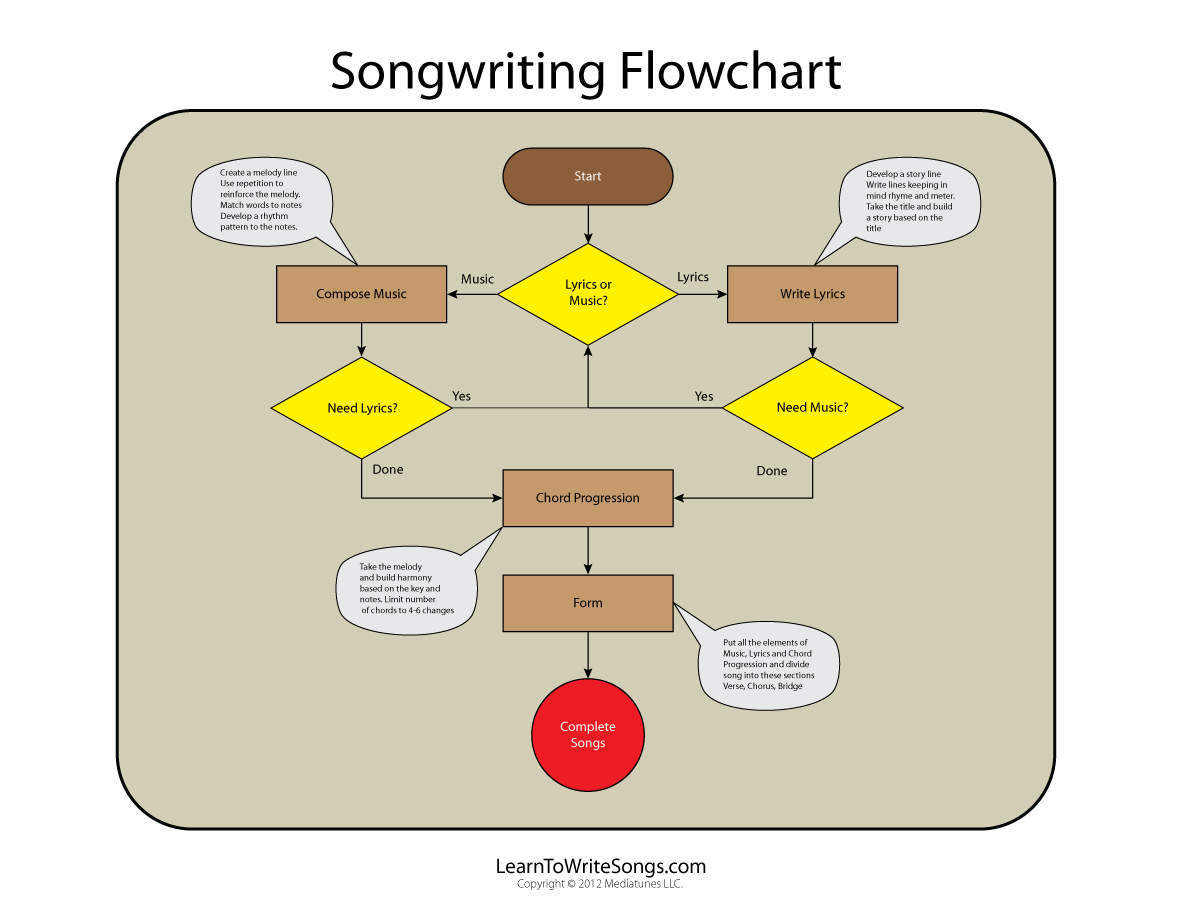Learn How to Write Songs for Beginners: Tips and Techniques
Songwriting is an art form that has been around for centuries. It is a way for people to express their thoughts, emotions, and experiences through music. Regardless of your experience learning to write songs can be a rewarding experience.. In this article, we will explore the basics of songwriting, including
- finding inspiration
- song structure
- writing lyrics
- melody creation
- harmony and chords
- rhythm and tempo
- songwriting software and tools
When anyone want to create music it is important to have basic knowledge of songwriting. The first step is finding inspiration. This can come from personal experiences, current events, or even other songs. Once you have an idea, you need to think about the structure of your song. This includes the verse, chorus, bridge, and other elements. Writing lyrics is also an important part of songwriting. You need to think about the message you want to convey and how you want to say it. Finally, you need to think about the melody, harmony, and rhythm of your song. These elements work together to create a cohesive and memorable piece of music.
Key Takeaways
- Songwriting allows people to express their thoughts, emotions, and experiences through music.
- Gain basic understanding of the basic of songwriting to start creating music.
- Discover various songwriting software and tools to help in the songwriting process. That include creating demos, organizing ideas. Plus learn about how to copyright your song.
Understanding the Basics of Songwriting
Songwriting is the process of creating a musical composition. A song consists of lyrics and melody. It is a form of art that requires creativity, passion, and dedication.
The following are some of the basic elements of songwriting:
Melody
The melody is the most important part of a song. It is the tune that people will remember and sing along to. A good melody should be catchy, memorable, and easy to sing. It should also fit the lyrics and convey the mood of the song.
Lyrics
The lyrics are the words that tell the story of the song. They should be meaningful, relatable, and well-written. A good lyricist should be able to convey emotions and ideas through their words.
Chords
Chords are the backbone of a song. They provide the harmony and structure that supports the melody and lyrics. A good songwriter should have a good understanding of chord progressions. They should also know and how to use them.
Structure
The structure of a song refers to the way it is organized. Most songs have a verse-chorus-verse-chorus-bridge-chorus structure. It is important to understand the basic structure of a song. As well as how to use it to create a cohesive and engaging piece of music.
Inspiration
Inspiration is the spark that ignites the songwriting process. It can come from anywhere, but it is important to be open to new ideas and experiences. A good songwriter should be able to draw inspiration from their own life and the world around them.
You can create meaningful and memorable music by mastering the following elements:
- melody
- lyrics
- chords
- structure
- inspiration
Finding Inspiration
When it comes to writing songs, finding inspiration can be a challenge. However, there are many ways to get inspired and start writing. Here are a few tips:
- Listen to music
Listening to other musicians can be a great source of inspiration. Pay attention to the lyrics, melodies, and chord progressions. Take note of what you like and what you don’t like, and use that to inform your own writing.
- Read poetry and literature
poetry and literature can be a great source of inspiration for songwriters. Look for themes and ideas that resonate with you, and use them as a starting point for your own lyrics.
- Take a walk
Sometimes, getting outside and taking a walk can help clear your mind and spark new ideas. Pay attention to your surroundings, and let your thoughts wander.
- Collaborate with other musicians
Collaborating with other musicians can be a great way to get inspired. Working with someone else can help you see things from a new perspective. It helps with coming up with ideas you might not have thought of on your own.
- Keep a journal
Keeping a journal can be a great way to capture ideas and inspiration when they strike. Write down lyrics, melodies, chord progressions, and anything else that comes to mind. You never know when something might come in handy.
By using these tips, you can find inspiration to start writing songs that are very meaningful.
Song Structure
Song structure refers to the organization of a song’s components. You need to know song structure as it provides a framework for songwriting. A typical song structure consists of verses, choruses, and bridges.
Verse
The verse is the section of the song that tells the story or delivers the message. The verse is usually eight to sixteen bars long. It repeats throughout the song with different lyrics. The verse sets up the story and creates anticipation for the chorus.
Chorus
The chorus is the most memorable part of the song. It is the section that repeats throughout the song with the same lyrics and melody. The chorus is the part of the song that listeners sing along to and is usually the catchiest part of the song. It is typically eight bars long and followed by a verse.
Bridge
The bridge is a section of the song that provides contrast to the verses and chorus. It is usually only used once in a song and is typically four to eight bars long. The bridge provides a break from the repetition of the verses. The chorus and can add a new perspective to the song’s message.
In conclusion, understanding song structure is essential for writing a successful song. The verse, chorus, and bridge provide a framework for songwriting. These elements allow for the creation of a memorable and cohesive song.
Writing Lyrics
When it comes to writing songs, lyrics are the heart and soul of the music. Writing lyrics requires creativity, imagination, and a good understanding of language. Here are some tips on how to write lyrics that will captivate your audience.
Rhyme Schemes
Rhyme schemes are patterns of rhyming words at the end of each line in a song. There are several types of rhyme schemes, such as AABB, ABAB, and ABCB. Each rhyme scheme has a unique sound and rhythm that can add depth and meaning to your lyrics.
One of the most common rhyme schemes is AABB. This song form is where the first two lines rhyme with each other and the second two lines rhyme with each other. This rhyme scheme is easy to follow and can create a catchy and memorable melody.
Another popular rhyme scheme is ABAB. This song form is where the first and third lines rhyme with each other. Then the second and fourth lines rhyme with each other. This rhyme scheme can create a more complex and sophisticated sound in your lyrics.
Storytelling
Lyrics are a form of storytelling, and the best songs are the ones that tell a compelling story. When writing lyrics, it’s important to have a clear idea of the story you want to tell. This can be a personal experience, a fictional tale, or a social commentary.
Creating a powerful story requires using descriptive language like metaphors, and imagery. This will help your audience visualize the story and connect with the emotions behind it. Remember to keep your lyrics concise and to the point. At the same time conveying the message you want to share.
In summary, writing lyrics is an art form that requires creativity, imagination, and a good understanding of language. By using rhyme schemes and storytelling techniques, you can create lyrics that will resonate with your audience.
Melody Creation
Creating a melody is one of the most important aspects of songwriting. It is the part of the song that people hum and remember. A good melody can make or break a song, so it is important to spend time crafting it.
When creating a melody, it is important to keep in mind the overall mood and message of the song. The melody should match the lyrics and convey the emotions of the song. It is also important to consider the musical range of the melody. To accommodate the singer or instruments that will be performing the melody.
One technique for creating a melody is to start with a simple chord progression. Once you have a chord progression build the melody around it. This can help ensure that the melody fits well with the music and creates a cohesive sound. Another technique is to use repetition and variation to create a memorable melody. Repeating a certain phrase or melody line can help make the melody more memorable. This will add variation to keep it interesting.
When creating a melody, it is also important to consider the rhythm. The rhythm of the melody should match the rhythm of the lyrics and the feel of the song. Using syncopation and varying the rhythm can add interest and energy to the melody.
Overall, creating a melody takes time and practice. It is important to experiment with different techniques. Find what works best for each individual song. With patience and persistence, anyone can learn how to create a memorable melody.
Harmony and Chords
Harmony and chords are two essential elements of songwriting. They create the foundation of the song and give it a sense of structure. Knowledge of harmony and chords helps a songwriter create a melody that is memorable and emotionally engaging.
Harmony refers to the combination of different notes played simultaneously. It is what gives a song its distinctive sound and character. Chords, on the other hand, are a group of notes played together to create a specific sound. They are the building blocks of harmony and are used to create the structure of a song.
When writing a song, choose the right chords to create the desired emotional impact. For example, minor chords are often used to create a sense of sadness or melancholy. While major chords are used to create a more upbeat and happy sound.
One tool to create interesting chord progressions is to use a circle of fifths. This is a sequence of chords that move in fifths, creating a sense of tension and release. Another technique is to use chord inversions. This involves changing the order of the notes in a chord to create a different sound.
In conclusion, understanding harmony and chords is essential for any songwriter. This who wants to create a memorable and emotionally engaging melody. Choosing the right chords and using them properly creates a song that will resonate with listeners.
Rhythm and Tempo
Rhythm and tempo are essential elements of any song. They can make or break a song, and understanding them is crucial for any aspiring songwriter. Rhythm refers to the pattern of sounds and silences in a song. Tempo refers to the speed at which those sounds and silences are played.
A good rhythm can help a song feel cohesive and can make it easier for listeners to follow along. It can also help create a sense of movement and energy in the song. There are many different types of rhythms, including:
- straight rhythms,
- syncopated rhythms
- polyrhythms
Each type of rhythm can create a different feel and energy in a song. So it’s important to experiment with different rhythms to find the right one for your song.
Tempo is also an important consideration when writing a song. The tempo can affect the mood and energy of the song, and can also affect how easy or difficult it is to sing or play. A slower tempo can create a more relaxed and introspective mood. Alternatively, a faster tempo can create a more upbeat and energetic feel.
When choosing a tempo for a song, it’s important to consider the genre and style of the song. A tempo that works well for a pop song may not be appropriate for a ballad or a country song.
In conclusion, understanding rhythm and tempo is essential for any songwriter. Experiment with different rhythms and tempos. Consider the genre and style of the song. This creates songs that are cohesive, energetic, and engaging.
Songwriting Software and Tools
Songwriting software and tools have become increasingly popular in recent years. They provide songwriters with a range of options to help them create, edit, and produce their music. These tools can be useful for both beginners and experienced songwriters. Helping them to streamline their workflow and improve their creative output.
One popular example of songwriting software is Ableton Live. It ch is widely used by musicians and producers to compose, record, and arrange music. This software includes features used to create a wide range of musical styles including:
- MIDI sequencing
- audio editing
- virtual instruments
Another popular option is Logic Pro X. It is a digital audio workstation designed for Mac users. This software includes a range of tools for composing and editing music, including:
- virtual instruments
- MIDI sequencing
- audio recording and editing
If you prefer a more traditional approach to songwriting, there are also physical tools available such as:
- notepads
- pencils
- chord charts
These tools can be useful for capturing ideas quickly and easily. This allows songwriters to focus on their creative process without technology distractions.
Songwriting software can be a valuable addition to any songwriter’s toolkit. It provides flexibility and control they need to create and produce their music. Whether you prefer digital or physical tools, there is a wide range of options available to suit your preferences.
Collaboration in Songwriting
Collaboration in songwriting can be a great way to bring new ideas and perspectives to a project. It allows for the sharing of skills and experiences. It can often result in a more well-rounded and polished final product.
When collaborating on a song, it’s important to establish clear expectations from the start. This can include discussing the overall vision for the song. And defining each person’s role in the collaboration, and how decisions will be made.
It’s also helpful to establish a timeline for the project. Also to set regular check-ins to ensure that everyone is on the same page. Monitoring that the project is progressing as planned.
Collaboration can take many forms. This includes co-writing lyrics and melodies to working together on arrangements and instrumentation. It’s important to be open to feedback and to be willing to compromise. This insures a cohesive and successful final product.
Collaboration in songwriting can be a rewarding and enriching experience for all involved. It can lead to some truly memorable and impactful music.
Practicing and Improving Songwriting Skills
To become a skilled songwriter, one must practice and refine their craft consistently. Here are some tips to help improve songwriting skills:
- Write regularly
Writing songs regularly is essential to improving songwriting skills. It helps to develop a habit of writing. It also provides opportunities to experiment with different styles and techniques.
- Study song structure
Understanding the structure of a song is crucial to writing a good one. Analyzing the structure of different songs can help develop an understanding of how to create a compelling melody and lyrics.
- Collaborate with other songwriters
Collaborating with other songwriters can provide valuable feedback. And it helps to develop new ideas. It can also help to identify areas of strength and weakness in songwriting.
- Experiment with different instruments and styles
Experimenting with different instruments and styles helps to develop a unique sound. It can also help to break out of creative ruts and generate new ideas.
- Listen to different genres of music
Listening to different genres of music can provide inspiration for new songs. And it helps to develop a diverse range of styles and techniques.
In conclusion, practicing and refining songwriting skills is essential to becoming a skilled songwriter. Consistently writing, studying song structure, collaborating with other songwriters, experimenting with different instruments and styles, and listening to different genres of music can help to improve songwriting skills and develop a unique sound and style.
Copyright and Protecting Your Songs
When it comes to songwriting, protecting your work is essential. Copyrighting your songs ensures that no one else can use or profit from them without your permission. Here are some ways to protect your songs:
Copyright Registration
The first step is to register your work with the appropriate organizations. In the United States, you can register your songs with the U.S. Copyright Office. This will give you legal proof of ownership and the right to sue if someone infringes on your copyright.
Use Copyright Notices
Another way to protect your songs is to include a copyright notice on all of your work. This lets others know that your songs are protected. So that the song cannot use them without your permission. A copyright notice should include
- the copyright symbol (©),
- the year of publication, and
- the name of the copyright owner.
Work with a Music Attorney
Working with a music attorney can also help you protect your songs. They can help you register your work, draft contracts, and provide legal advice if someone infringes on your copyright.
Keep Records
Keeping records of your songs is important in case you need to prove ownership. This can include recordings, lyrics, and any other documentation that shows you created the work.
By taking these steps, you can protect your songs and ensure that you are the only one who can profit from your hard work.
Frequently Asked Questions
What are some of the best songwriting software options available?
There are several software options available for songwriting, including
- Logic Pro X
- Ableton Live
- GarageBand
These software options offer a range of features for composing and arranging music, recording demos, and mixing tracks. It’s important to choose a software that fits your needs and budget.
How can one learn the fundamentals of songwriting?
Learning the fundamentals of songwriting involves understanding the basics of melody, harmony, and rhythm. It’s also important to study the structure of songs and the use of lyrics to convey meaning and emotion. One can learn these fundamentals through online courses, books, or by studying the work of successful songwriters.
What are the steps to starting to write song lyrics?
The first step to writing song lyrics is to choose a topic or theme. From there, one can brainstorm ideas and start writing down phrases or lines that fit the theme. It’s also important to consider the structure of the song and how the lyrics will fit within it. Finally, revising and editing the lyrics is crucial to creating a polished final product.
What are some tips for writing a song from the heart?
To write a song from the heart, it’s important to tap into personal experiences and emotions. One can also draw inspiration from the world around them or from the experiences of others. It’s important to be honest and authentic in the lyrics and to focus on conveying a clear message or emotion.
Can songwriting be self-taught, and if so, how?
Yes, songwriting can be self-taught. One can start by studying the work of successful songwriters. And by analyzing the structure and lyrics of their songs. It’s also important to practice regularly and to seek feedback from others. Online courses and resources can also be helpful in developing one’s skills.
What are some beginner-friendly resources for learning how to write songs?
There are several beginner-friendly resources available for learning how to write songs, including:
- online courses
- books
- workshops
It’s important to choose a resource that fits your learning style and budget. Seeking feedback from others and practicing regularly are also key to developing one’s skills.





